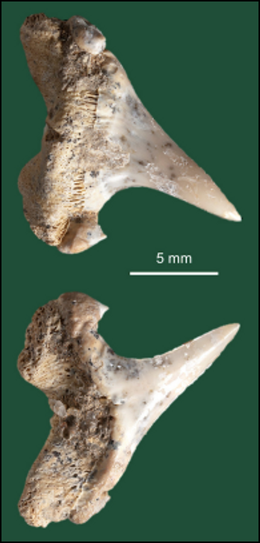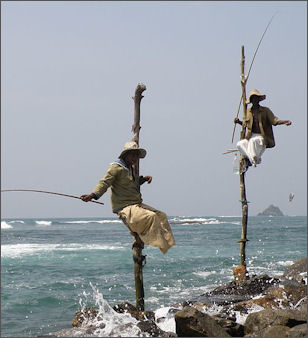Home | Category: Commercial and Sport Fishing and Fish
NEANDERTHALS IN SPAIN LIVED MAINLY ON SEAFOOD 150,000 YEARS AGO
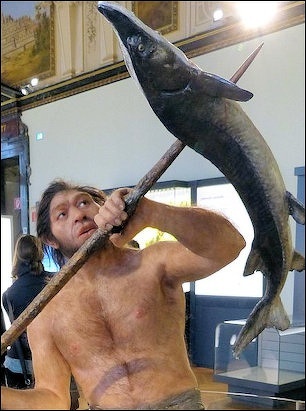
Neanderthal fishing?
Neanderthals occupying caves in southern Spain lived on a diet of seafood earlier than previously thought — 150,000 years ago — archaeological findings show. Fiona Govan wrote in The Telegraph: “Archaeological examination of a cave in Torremolinos unearthed early tools used to crack open shellfish collected off rocks along the Iberian coast and found fossilised remains of the early meals. The discovery is the earliest of its kind in northern Europe and shows that early man were fish eaters in Europe some 100,000 years earlier than previously thought and that that early coastal cavemen supplemented their hunter/gatherer diet of nuts, fruits and meat from animals such as antelopes and rabbits with seafood. [Source: Fiona Govan, The Telegraph, September 15, 2011 /~/]
“A team of archaeologists from Seville University and scientists from the National Council for Scientific Investigation (CSIC) published their research this week after a lengthy investigation involving the scientific dating of fossilised remains from the cave. The Cueva Bajondillo on Andalusia’s southern coast near Malaga contained remains of burned mussel shells and barnacles indicating that Middle Paleolithic hominins had collected and cooked the shellfish for consumption. /~/
“The discovery suggests that Neanderthals in Europe and Archaic Homo sapiens in Africa were following parallel behavioural trajectories but with different evolutionary outcomes, the paper claims. “It provides evidence for the exploitation of coastal resources by Neanderthals at a much earlier time than any of those previously reported,” said Miguel Cortés Sánchez who led the Seville University team. “The use of shellfish resources by Neanderthals in southern Spain started some 150,000 years ago,” the paper concluded. “It was almost contemporaneous to Pinnacle Point (in South Africa) when shellfishing is first documented in archaic modern humans.”“ /~/
Related Articles: COMMERCIAL FISHING: CONSUMPTION, DEMAND, LEADING NATIONS, SPECIES ioa.factsanddetails.com ; CATEGORY: COMMERCIAL AND SPORT FISHING AND FISH ioa.factsanddetails.com
Neanderthals Ate Sharks, Dolphins and Salmon
Neanderthals in present-day Portugal ate sharks, dolphins, fish, mussels and seals according to a study published in March 2020 in the journal Science.. The BBC reported: Scientists found evidence for an intensive reliance on seafood at a Neanderthal site in southern Portugal. Neanderthals living between 106,000 and 86,000 years ago at the cave of Figueira Brava near Setubal were eating mussels, crab, fish — including sharks, eels and sea bream — seabirds, dolphins and seals. [Source: Paul Rincon, Science editor, BBC News website, 26 March 2020]
The research team, led by Dr João Zilhão from the University of Barcelona, Spain, found that marine food, including sharks and dolphins, made up about 50 percent of the diet of the Neanderthals who lived in Figueira Brava in what is now Portugal. The other half came from terrestrial animals, such as deer, goats, horses, aurochs (ancient wild cattle) and tortoises.
Some of the earliest known evidence for the exploitation of marine resources by modern humans (Homo sapiens) dates to around 160,000 years ago in southern Africa. A few researchers previously proposed a theory that the brain-boosting fatty acids seafood contributed to enhanced cognitive development in early modern humans. This, the theory goes, could help account for a period of marked invention and creativity that started among modern human populations in Africa around 200,000 years ago. It might also have assisted modern humans to outcompete other human groups such as the Neanderthals and Denisovans.
But the researchers found that the Neanderthal inhabitants of Figueira Brava relied on the sea in a scale comparable to modern human groups living at a similar time in southern Africa. Commenting on the findings, Dr Matthew Pope, from the Institute of Archaeology at UCL, UK, said: "Zilhão and the team claim to have identified 'middens'. This is a shorthand for humanly created structures (piles, heaps, mounds) formed almost entirely of shell.
Phys.org reported: “In a joint study, Professor Hervé Bocherens of the University of Tübingen, Germany, together with colleagues from the Zoological Institute of the Russian Academy of Sciences in Saint Petersburg, Russia and the Royal Belgian Institute of Natural Sciences in Brussels, Belgium have found at a cave in the Caucasus Mountains indirect hints of fish consumption by Neandertals. Bone analyses ruled out cave bears and cave lions to have consumed the fish whose remains were found at the Caucasian cave. [Source: phys.org, September 17, 2013 =]
“On the northern slopes of the Caucasus Mountains, called Kudaro 3, the bone fragments of large salmon, migrating from marine water to their freshwater spawning places, were found in the Middle Palaeolithic archaeological layers, dated to around 42 to 48,000 years ago, and probably deposited by Neandertals. Such remains suggested that fish was consumed by these archaic Humans. However, large carnivores, such as Asiatic cave bears (Ursus kudarensis) and cave lions (Panthera spelaea) were also found in the cave and could have brought the salmon bones in the caves. =
“To test this hypothesis, the possible contribution of marine fish in the diet of these carnivores was evaluated using carbon, nitrogen and sulphur isotopes in faunal bone collagen, comparing these isotopic signatures between predators and their potential prey. The results indicate that salmons were neither part of the diet of cave bears (they were purely vegetarian, like their European counterparts) or cave lions (they were predators of herbivores from arid areas). =
“This study provides indirect support to the idea that Middle Palaeolithic Hominins, probably Neandertals, were able to consume fish when it was available, and that therefore, the prey choice of Neandertals and modern humans was not fundamentally different,” says Hervé Bocherens. He assumes that more than diet differences were certainly involved in the demise of the Neandertals.”
Early Humans Were Skilled Deep-Sea Fishermen 42,000 Years Ago
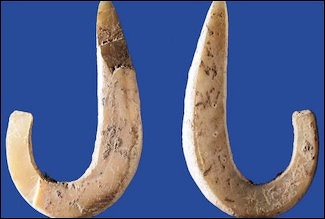
world's oldest fish hooks, from East Timor
More than 40,000 years ago, prehistoric humans living in what is now East Timor ago possessed the skills necessary to catch deep ocean fish such as tuna. Discovery News reported: “In a small cave at the eastern end of East Timor, north of Australia, archaeologist Sue O’Connor from the Australian National University has unearthed the bones of more than 2,800 fish, some of which were caught as long as 42,000 years ago. [Source: Discovery News, November 28, 2011 |^|]
“The find shows that the people living in the region had the sophisticated cognitive skills needed to haul in such a difficult catch, O’Connor says. Her findings appeared in the journal Science. “What the site has shown us is that early modern humans in island Southeast Asia had amazingly advanced maritime skills,” she said. “They were expert at catching the types of fish that would be challenging even today — fish like tuna. It’s a very exciting find.” |^|
“It isn’t clear exactly what techniques the people living in the area at the time used to catch these fish. Tuna can be caught using nets or by trolling hooks on long lines through the water, O’Connor said. “Either way it seems certain that these people were using quite sophisticated technology and watercraft to fish offshore. She said it also demonstrated prehistoric man had high-level maritime skills, and by implication, the technology needed to make the ocean crossings to reach Australia.|^|
“The site where the discoveries were made, known as Jerimalai cave, is a small rock overhang hidden behind in foliage, a few hundred meters from the shore. “When I discovered it in 2005, I didn’t think that Jerimalai would tell us about the very early occupation of Timor,” O’Connor said. “I was quite surprised when I found all these fish bones and turtle bones.” So far, she and her colleagues have only excavated two small test pits at the cave, which contained a number of stone artifacts, bone points, animal remains, shell beads and fish hooks. In just one of those pits, 1 meter square and 2 meters deep, they found 39,000 fish bones. . “I think Jerimalai gives us a window into what maritime coastal occupation was like 40,000 to 50,000 years ago that we don’t really have anywhere else in the world,” said O’Connor. |^|
O’Connor said: “They were expert at catching the types of fish that would be challenging even today - fish like tuna. It's a very exciting find. Simple fish aggregating devices such as tethered logs can also be used to attract them. So they may have been caught using hooks or nets,' she said. 'Either way it seems certain that these people were using quite sophisticated technology and watercraft to fish offshore.” [Source: Simon Tomlinson, Daily Mail, November 25, 2011]
According to the Daily Mail: “She added that the finds may shed light on how Australia's first inhabitants arrived on the continent, with the implication that seaworthy boats would have been used to fish in the deep ocean. “Ee have known for a long time that Australia's ancient ancestors must have been able to travel hundreds of kilometres by sea because they reached Australia by at least 50,000 years ago,' said O'Connor. 'When we look at the watercraft that indigenous Australians used at the time of European contact, however, they are all very simple, like rafts and canoes.”“
World’s Oldest Fish Hooks Also Found in East Timor
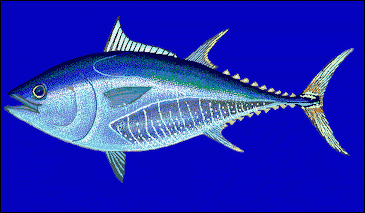
bluefin tuna
O’Conner’s team also unearthed another rare find — a small piece of fishing hook made from a shell, which dates to between 23,000 and 16,000 years ago. This is the earliest example of a fishing hook that has ever been found, the researchers say. [Source: Discovery News, November 28, 2011 |^|]
Nikhil Swaminathan wrote in Archaeology magazine: “Two 11-square-foot pits dug in Jerimalai Cave on the east end of East Timor have provided some of the earliest evidence of fishing technology. Though there is little evidence of fishing activity beyond 10,000 years ago, fragments of fish hooks found in the cave date to between 16,000 and 23,000 years ago, making them the oldest ever recovered. A more complete hook dating to 11,000 years ago was also found at the site. [Source: Nikhil Swaminathan, Archaeology, Volume 65 Number 2, March/April 2012 ]
“The inch-long hooks, all of which were made of shells from sea snails, would have been used to catch shallow-water fish, such as grouper and snapper, says Sue O'Connor, an archaeologist at Australian National University, who coauthored a study on the finds in Science. "They would have had a fiber line attached to the shank, and bait put on the hook," she explains. "Then, they would be cast or lowered into the water and left stationary."
“Fish bones were also found in the deposits. Offshore species, such as tuna, account for nearly 50 percent of the remains dating to earlier than 7000 B.C. After that, shallow-water and reef species start to dominate, likely due to warmer climate and the proliferation of reef habitat. The variety of the bones depicts the humans of the time as skilled seafarers capable of fishing many species in both shallow and deep water.”
O’Conner’s team discovered fish bones from 2,843 individual fish of 23 different taxa, including tuna and parrotfish. Sandra Bowdler at the University of Western Australia in Perth, who was not involved in the study, is convinced that those colonising East Timor 42,000 years ago had “fully formed” fishing skills. “By this time, modern humans are assumed to have the same mental capacities as today,” she says. “There is nothing like this anywhere else in the world,” says Ian McNiven of Monash University in Melbourne, who was not a member of O’Connor’s team. “Maybe this is the crucible for fishing.” [Source: Wendy Zukerman, Newscientist, November 24, 2011]
East Timor hosts few large land animals, so early occupants would have needed highly developed fishing skills to survive. “Necessity is the mother of invention,” says O’Connor. “Apart from bats and rats, there’s nothing to eat here.” But that doesn’t necessarily mean that fishing began in the region. At the time, sea-levels were around 60 to 70 metres lower than today. Any sites of former human occupation that were located on the Pleistocene shore – rather than in coastal cliffs like the Jerimalai shelter – are now submerged.
Oldest Fishing Net Sinkers — 29,000 Years Old — Found in South Korea
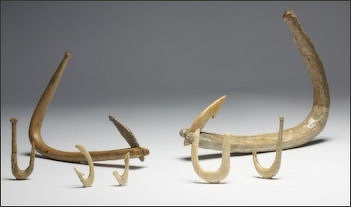
Irie-Takasago Shell Midden fish hooks
In 2018, scientists announced that limestone sinkers, tied to the bottom of nets and used to catch small fish such as minnows in shallow streams, found in South Korea were the oldest known net sinkers and some the earliest of fishing with nets. AFP reported: “Carbon dating procedures on the fourteen limestone sinkers, unearthed in the eastern county of Jeongseon in June, 2018 have pushed back “the history of fishing by nets by some 19,000 years”, Yonsei University Museum director Han Chang-gyun told AFP. [Source: AFP, August 7, 2018]
“Previously, researchers had excavated sinkers—stones used to weigh down nets for catching fish—in Japan’s Fukui Prefecture and South Korea’s Cheongju city, but those discoveries were all dated back to the Neolithic Era and believed to be around 10,000 years old, Han said. “This discovery suggests humans in the Upper Paleolithic era were actively catching fish for their diet”, he added. ||
“The limestone sinkers, each weighing between 14 to 52 grammes and with a diameter of 37 to 56 millimetres, had grooves carved into them so they could be tied to the bottom of nets and used to catch small fish such as minnows in shallow streams, he said. Researchers also found fossilized bones belonging to fish and other animals, as well as stone tools and flakes, inside the Maedun cave, he said. Prior to the South Korean find, the oldest fishing implements were believed to be fishing hooks, made from the shells of sea snails, that were found on a southern Japanese island and said to date back some 23,000 years.” ||
Reindeer Hunters Fished Ice-Age Lakes in Germany 19,000 Years Ago
Scientists have unearthed six fishhooks, the oldest of which was made from a 19,000-year-old mammoth tusk, in Germany. Tia Ghose wrote in Lives Sience: “Hunters of ice age reindeer around 12,300 years ago likely left the fishhooks, along with mammal and fish bones, in an open field in what is now Wustermark, Germany. The fishhooks, which are the oldest found in Europe, suggests humans developed fishing tools earlier than previously thought, probably to catch fast-moving fish that appeared in lakes as the climate warmed. “These people had strong ideas to use the new resources of this changing environment,” said Robert Sommer, a paleoecologist at the University of Kiel in Germany. The eel, perch and pike that entered lakes are too fast to snag with a harpoon or a spear, Sommer added. The findings are detailed in the May 2013 issue of the Journal of Archaeological Science. [Source: Tia Ghose, livescience. March 8, 2013 +]
“Most archaeological evidence for ancient seafood consumption has washed away with rising sea levels. And until now, archaeologists in Europe thought hunter-gatherers around 12,000 years ago speared slow-moving fish like salmon in shallow streams, but didn’t use hooks until much later, Sommer told LiveScience. +\
“Sommer and his colleagues unearthed several Paleolithic finds during a routine environmental assessment prior to building a shopping mall 12.4 miles (20 kilometers) west of Berlin. The site, which was once an open field near an ancient lake, revealed six fishhooks, along with animal and fish remains. One of the fishhooks was carved from ivory from a mammoth tusk, while the rest were made of reindeer or elk bones closer to 12,300 years of age. Because mammoths went extinct before the fishermen lived, the people probably found a whole tusk and used it millennia later, Sommer told LiveScience. +\
“The fishhooks are impressive because they show the sophistication of ancient hunters, said Sue O’Connor, an archaeologist at the Australian National University, who found the East Timor fishhooks, but was not involved in this study “There’s a lot of planning that’s gone into the development of these particular hook shapes,” O’Connor told LiveScience. “You’ve got to have it at the right angle so it actually hooks the fish, otherwise the fish just gets off.”“ +\

Fishing in Jomon Period Japan (13,000 B.C. to 400 B.C.)
Aileen Kawagoe wrote in Heritage of Japan: “Jomon people living in bays and coastal areas dived so regularly that they developed bony ear mechanisms (like prehistoric divers elsewhere in the world). Inland, the mountain streams and rivers in Japan teemed with fishes…salmon, trout spawning in the spring. The Jomon people were able to catch large harvests of fish daily by setting traps with their willow baskets or brush weirs in the mountain streams or in estuaries and on tidal flats. During the summer, the Jomon people fished intensively all along the coast, mostly in shallow inlets and water zones using fishing hooks and nets. They caught small schools of fishes of as sardines, halfbeak and horsemackerel and many other types of fish with their nets.” [Source: Aileen Kawagoe, Heritage of Japan website, heritageofjapan.wordpress.com ]
“The Jomon hunter’s bundle of tools included stone spear and arrowhead points, fishhooks, harpoons, line, float, spears, nets, pumice floats, stone sinkers, and needles made of deer antler bone, knives for cutting ropes and for processing the catch. The boat and paddle, were important tools of course. The Jomon fisherfolk are particularly famous for their fishhooks and toggle-headed harpoons that the Jomon hunters used to catch fish and sea mammals with.
“Many dugout canoes have been found from the Early Jomon era. These had been used to go to sea. They also caught black snapper, red snapper, Japanese sea bass and flatfishes. But being able to go out to open sea meant being able to bring home catches of larger fishes like tuna, salmon and sea mammals. Particularly in the north of Japan, deep-sea fish such as tuna, bonito and salmon or trout were important food resources for the Jomon people. Other species of fishes caught include eel, the Japanese flounder, sea perch, red sea bream, black porgy, herring, scorpian fish, mullet, bartailed flathead, brutal moray, opal eye, mackerel, horsemackerel, parrotfish and shark.
See Separate Article JOMON FISHING, PROTO-AGRICULTURE AND TRADE factsanddetails.com
Seafood in Ancient Rome
Romans were very fond of fish sausage. Sausages made by stuffing spiced meat into animal intestines were made by the Babylonians around 1500 B.C. The Greeks also ate such foods. The Romans called them salsus, the source of the word sausage.
 <br/>
Romans ate lobster, crab, octopus, squid, cuttlefish, mullet, sea urchins, scallops, clams, mussels, sea snails, tuna, sea bream, sea bass and scorpion fish. They liked to cook fish live at the table and the Senate once debated the proper way to serve the first turbot. Hadrian was fond of salmon rolled with caviar. Fresh oysters were very popular. They were brought to Rome from Breton in modern-day France by runners in around 24 hours.
<br/>
Romans ate lobster, crab, octopus, squid, cuttlefish, mullet, sea urchins, scallops, clams, mussels, sea snails, tuna, sea bream, sea bass and scorpion fish. They liked to cook fish live at the table and the Senate once debated the proper way to serve the first turbot. Hadrian was fond of salmon rolled with caviar. Fresh oysters were very popular. They were brought to Rome from Breton in modern-day France by runners in around 24 hours.
The Romans made popular fish soup in huge vats. The upper classes ate peppered fish. The Romans were so fond of fish they badly overfished the Mediterranean. The Romans practiced fish farming and raised eels in tanks. Pliny described one aristocrat who occasionally fed his slaves to the eels.
Harold Whetstone Johnston wrote in “The Private Life of the Romans”: “The rivers of Italy and the surrounding seas must have furnished always a great variety of fish, but in early times fish were not much used as food by the Romans. By the end of the Republic, however, matters had changed, and no article of food brought higher prices than the rarer sorts of fresh fish. Salt fish was exceedingly cheap and was imported in many forms from almost all the Mediterranean harbors. One dish especially, tyrotarichus, made of salt fish, eggs, and cheese, and therefore something like our codfish balls, is mentioned by Cicero in about the same way as we speak of hash. Fresh fish were all the more expensive because they could be transported only while alive. Hence the rich constructed fish ponds on their estates—Lucius Licinius Crassus setting the example in 92 B.C: and both fresh-water and salt-water fish were raised for the table. The names of the favorite sorts mean little to us, but we find the mullet (mullus) and a kind of turbot (rhombus) bringing high prices, while oysters (ostreae) were as popular as they are now.” [Source: “The Private Life of the Romans” by Harold Whetstone Johnston, Revised by Mary Johnston, Scott, Foresman and Company (1903, 1932) forumromanum.org ]
Ancient Mosaics Reveal Changing Fish Size
Rossella Lorenzi wrote in discovery.com: “The dusky grouper, one of the major predators in the Mediterranean sea, used to be so large in antiquity that it was portrayed as a “sea monster,” a new study into ancient depictions of the endangered fish has revealed. “Amazingly, ancient mosaic art has provided important information to reconstruct this fish’s historical baseline,” Paolo Guidetti of the University of Salento in Italy, told Discovery News. [Source: Rossella Lorenzi, news.discovery.com, September 13, 2011 -]
“Considered one of the most flavorful species among the Mediterranean fish, the dusky grouper (Epinephelus marginatus) is a large, long-lived, slow-growing, protogynous hermaphrodite fish (with sex reversal from female to male). It can be found mainly in the Mediterranean, the African west coast and the coast of Brazil. Having faced harvesting for millennia — grouper bones have been found in human settlements dating back more than 100,000 years — this species has been decimated in recent decades by commercial and recreational fishing. It is now categorized as endangered.-
“To look farther back into the grouper’s history, the researchers examined hundreds of Etruscan, Greek, and Roman paintings and mosaics depicting fishing scenes and fish. At the end, they focused on 23 mosaics which represented groupers. In 10 of the 23 mosaics, dating from the 1st to 5th centuries, groupers were portrayed as being very large. Indeed, the ancient Romans might have considered groupers some sort of “sea monsters” able to eat a fisherman whole, as shown in a 2nd century mosaic from the Bardo National Museum in Tunis. -
fishermen in Sri Lanka “The mosaics also indicated that groupers lived in shallow waters much closer to shore, and were caught by fishermen using poles or harpoons from boats at the water’s surface. It’s a technique that would surely yield no grouper catch today,” said the researchers. Although there are no known instances of dusky groupers attacking human swimmers, the art depictions are very “informative,” said the researchers. These representations suggest that groupers were, in ancient times, so large as to be portrayed as sea monsters and that their habitat use and depth distribution have shifted in historical times,” Guidetti and Micheli wrote. -
“Ancient Roman authors such Ovid (43 B.C. – 18 A.D.) and Pliny the Elder ((23 A.D. – 79 A.D.) reported that groupers were fished by anglers in shallow waters, where they are now rare if not completely absent. According to their accounts, fish were so strong they could break fishing lines. Ancient art provides a link between prehistorical and modern evidence and suggests that shallow near shore Mediterranean ecosystems have lost large, top predators and their corresponding ecological roles,” the researchers concluded.” -
Almadradas and Tonnar
Fishermen have been catch bluefin tuna in the Mediterranean for more than 3,000 years. Using a technique that has been employed since Roman times, fishermen in southern Spain and Italy set up fixed trap nets known as almadradas in Spanish and tonnara in Italian---a labyrinth of nets anchored in shallow waters near the coast that funnels fish into chambers, where they were slaughtered. [Source: Fen Montaigne, National Geographic, April 2007]
In the mid 1800s around a hundred of these tuna traps harvested up to 15,000 tons of bluefin annually. The fishery was sustainable, supporting thousands of workers and their families. Today all but a dozen or so have been closed because of coastal development, pollution and overfishing. One of the last remaining ones that is open was built by Arabs in the 9th century on the island of Favignana of Sicily. In 1864 fisherman there caught a record 14,020 bluefin, averaging 425 pounds. In 2006, they caught around 100 fish, averaging 65 pounds. That year only one mattanza ---in which the tuna and channeled into a netted chamber and slaughtered at the surface by fishermen who kill them with gaffs---was held. There are now plans to dress fishermen in historic costumes and reenact the mattanza.
Traditional Fishing
Local fisherman traditionally set out before dawn and return late in the morning and take a long mid-day nap. Ancient fish traps used in Micronesia are made from stones placed in a V-shaped formation that traps fish as they return to deeper water when the tide goes out. In Indonesia, fishermen use bamboo traps that allow fish to go in but not come out.
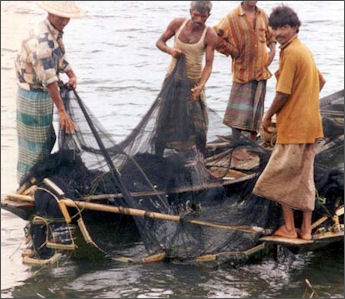
Bangladesh fishermen On the ancient practice of trout tickling, Abraham Rinquist wrote in Listverse: This fishing technique requires no equipment, just stealth. You approach a likely trout hole from downstream. Lie stomach-down on the bank. Reach into the water. Once you feel a trout, tickle the belly as you move tail-to-head to lull the fish. When you reach the head, squeeze and yank the fish out of the water. For centuries, this technique has been popular among Europe’s poor. They could not afford equipment or pay to fish private land. It is generally considered a form of poaching. Gypsy guitarist Django Reinhardt, the first notable European jazz musician, was known as an expert trout tickler. Perhaps the dexterity required to play stringed instruments translates to trout tickling. [Source: Abraham Rinquist, Listverse, September 16, 2016]
On flounder tramping, Rinquist wrote: Flounders are a flat fish known for their white flakey flesh. Their low profile and penchant for crabs often means they are found in the shallows around estuaries. Ingenious hunters have found out how to harvest this delicious fish with a diabolically simple technique: They step on them. Flounder tramping is a traditional fishing technique used in southwestern Scotland for centuries. The process is simple. You walk along the mud flats until you step on a flounder. At this point, a fight against instinct occurs. Every impulse tells you to remove your foot from the fish. However, you must stand firm, or the quarry will escape. Some trampers also employ a stick, which they use behind their shuffling feet. On the first Saturday of August, the small town of Palnackie, Scotland, hosts the World Flounder Tramping Competition. The fun is broadcast throughout the UK and Australia.
Traditional Fishing in Japan
Lookbox fisherman in Suruga Bay in Japan use a device which looks like a cheerleader megaphone to locate fish in the shallow part of the sea. The "lookbox" has a piece of glass in it, which the fisherman look through to seas the shallow sea bottom. The fishermen use spears to catch fish and a tool resembling a giant dentist probe to get crabs out of their hiding places where they can be scooped up by small nets. [Source: David Doubilet and Eugenie Clark, National Geographic October 1990]
Japanese fisherman catch octopus in earthen jars that are tied together with ropes and dropped to the bottom of the sea. Octopus's apparently like dark places to crawl into the jars and hide so not bait or lid is necessary and the animals will stay in the jars even when they are hauled aboard a boat. On a good day about half on the jars that a fisherman has submerged will contain four or five pound octopuses. If an octopus is found with a leg missing it usually means it has eaten itself to stave off starvation. [Source: Bart McDowell, National Geographic, March 1974]
Squid are caught at night from squid jigger ships draped with bright lanterns that attract the squid which are caught with weighted and hooked lines that move up and down (jig) with the help of a hydraulic system. The waters between Japan and Korea are filled with lit-up squid boats as you will notice if you ever fly over the Sea of Japan at night.
Freshwater Fish Farms in China
Freshwater fish farming dates back to the Tang Dynasty in the 7th century. Traditional fish farms raised several species of carp — grass, bighead, silver, common and mud cap — together. Each type either feeds on grass and aquatic life, plankton and organic matter on the bottom.
The Chinese have traditionally raised four kinds of fish in freshwater fish farms: 1) carp that fed on zooplankton, 2) carp that fed on phytoplankton 3) carp that feed on grass, and 4) carp feed on detritus. They live together in an balanced sustainable, ecologically-sound way.
Freshwater fish farms are replacing traditional agricultural plots. Many people has fish ponds on their farms.. Fish in southern China are caught in lakes with mesh fish traps, and are raised backyard fish ponds. Some farmers raise fish in flooded rice paddies. The fish feed on weeds and insects. Their waste fertilizers crops.
Fishing and Overfishing in Medieval Europe
Elizabeth Kolbert wrote in The New Yorker, “In an effort to figure out what ocean life was like before the modern era, marine scientists have, in the past few decades, cored through seafloor sediments, measured the size of fish bones tossed out at ancient banquets, and combed through the logs of early explorers. As Callum Roberts reports in “The Unnatural History of the Sea” (2007), the work suggests that humans have been wreaking havoc in the oceans for centuries.” [Source: Elizabeth Kolbert, The New Yorker, August 2, 2010]

10th century fish farming in China
Before the 11th century in Europe and England most fishing was done in freshwater lakes and rivers. Archeologists analyzing discarded fish bones going back 14 centuries observed freshwater fish became scarcer over time and concluded that mill dams began blocking salmon from swimming upstream in the 1100s.
Europeans began eating more fish from the sea in the Middle Ages starting around the 11th century. There were several reason for this. Fishing technology had improved and vessels were made more seaworthy. The quality and quantity of freshwater fish was declining as a result of overfishing and “deteriorating freshwater” tainted by pollution and sewage.
As methods for preserving and transporting fish improved, catches grew larger. As coastal fishing areas became depleted and saltwater fish became smaller and smaller fishermen began venturing further and further away from home and further out to sea.
The Age of Exploration not only opened up new continent for colonization and exploitation it also expanded the world and its oceans and opened the way for the exploitation it marine life. Many animals on both land and sea were killed for provisions. Some places were overfished hundreds of years of ago. Whales and seals were the first forms of marine life to be slaughtered to the edge of extinction.
Summing all this up, Kolbert wrote in The New Yorker, “Consider the example of Britain. Archeological deposits show that around the year 1000 Europe’s freshwater fisheries were already in decline, perhaps owing to overfishing or perhaps to the erection of dams and mills that impeded river flows. To make a living, British fishermen set out to sea. Initially, the marine catch appears to have been bountiful; analysis of what might be described as eleventh-century garbage shows that people in what is now Scotland dined on four-foot-long cod and five-foot-long pollack. But gradually local stocks were fished down, and by the fifteenth century British ships were venturing as far away as Norway and Iceland. (The Danes, who claimed Iceland for themselves, complained that the English were setting up entire villages on the island, “putting up tents, digging ditches, working away.”) When, in the early sixteenth century, British fishermen turned their attention to the newly discovered fisheries off Newfoundland, they encountered, in the words of one early settler, “Cods so thicke by the shoare that we heardlie have been able to row a Boate through them,” and the cycle began all over again.
Development of Modern Fishing
Conspicuously wasteful and destructive fishing methods grew and became widespread along with steam-powered fishing ship, which were developed in the 1870s. Many of these employed trawl nets, which were invented in the 14th century, and dragged up everything that got in their way, even before steam power became widely used, Callum Roberts wrote in “The Unnatural History of the Sea” “fishers complained that the trawlers were wiping out fish stocks, especially by the destruction of fish spawn and immature fish,” that “the trawls cleared the bottom and ruined their bait beds, that “crab populations were imperiled by soft crabs being crushed when shedding their shells” and that “the trawl broke up and dispersed schools of fish, driving them away.”
One of the great advancements in fish production was salting herrings directly as it came from the sea, reducing the time-consuming drying stage and reducing the potential for spoilage from exposure to air. The fact that fish can be easily frozen and stored is one of the primary reasons it such a big global industry today.
Elizabeth Kolbert wrote in The New Yorker, “The Great International Fisheries Exhibition, which took place in London in 1883, was a celebration of all things piscatorial. More than two thousand exhibitors from around the world displayed herring nets and salmon ladders, trout rods and eel spears, life buoys and lamprey baskets. Awards — dozens of them were bestowed — included twenty pounds sterling for the best collection of smoked fish, twenty-five pounds for the best model of a sailing trawler, and ten pounds for the “best Apparatus for, or Method of, protecting Young Brood and Oysters against Dog Whelks and other natural enemies.”
Thomas Huxley, who is now mostly remembered for being an early supporter of Charles Darwin, was at the time the president of Britain’s Royal Society, and he delivered the exhibition’s opening address. As his topic, Huxley chose the question “Are fisheries exhaustible? That is to say, can all the fish which naturally inhabit a given area be extirpated by the agency of man?” The answer, Huxley decided, was a qualified no. Although people might be able to wipe out the salmon in a certain stream by throwing a net across it “in such a manner as to catch every salmon that tries to go up and every smolt that tries to go down,” conditions in the ocean were altogether different.

factory fishing ship
“Probably all the great sea fisheries are inexhaustible; that is to say that nothing we do seriously affects the number of the fish,” Huxley declared. To the extent that there was a problem with the fishing industry, it was due to its “relative backwardness.” Fishing, Huxley said, had failed “to keep pace with the rapid improvement of almost every other branch of industrial occupation in modern times” and still lagged “very far behind scientific agriculture . . . as to the application of machinery.”
Huxley’s views dominated thinking about fisheries for most of the next century. In 1955, Francis Minot, the director of the Marine and Fisheries Engineering Research Institute, in Woods Hole, Massachusetts, co-wrote a book titled “The Inexhaustible Sea.” As yet, he observed, “we do not know the ocean well enough. Much must still be learned. Nevertheless, we are already beginning to understand that what it has to offer extends beyond the limits of our imagination.” In 1964, the annual global catch totalled around fifty million tons; a U.S. Interior Department report from that year predicted that it could be “increased at least tenfold without endangering aquatic stocks.” Three years later, the department revised its estimate; the catch could be increased not by a factor of ten but by a factor of forty, to two billion tons a year. This, it noted, would be enough to feed the world’s population ten times over. Michael L. Weber observes, in “From Abundance to Scarcity” (2002), that as recently as the nineteen-nineties U.S. policy was predicated “on the belief that the ocean’s productivity was almost limitless.”
In the meantime, “machinery” beyond Huxley’s wildest imagining was being developed. Purse seines were introduced in the nineteen-thirties. These giant nets can be played out around entire schools of fish, then gathered up with drawstrings, like huge laundry bags. Factory freezer trawlers, developed after the Second World War, grew to be so gargantuan that they amounted to, in effect, seafaring towns. In the nineteen-fifties, many fleets added echo-sounding sonar, which can detect fish schools long before they surface. Today, specially designed buoys known as “fish aggregating devices,” or FADs, are deployed to attract species like yellowfin tuna and blue marlin. So-called ‘smart’ FADs come equipped with sonar and G.P.S., so operators can detect from afar whether they are, in fact, surrounded by fish.
Recent History of Fishing and Overfishing
Rachel Carson, the author the 1960s book “Silent Spring”, regarded by some as the founder of the environmental movement. Elizabeth Kolbert wrote in The New Yorker in 1943 she was a young biologist working for the U.S. Fish and Wildlife Service when she wrote a booklet titled “Food from the Sea.” The point of the boosterish guide was to convince American consumers of the delectableness of fish like the wolffish, an enormous creature with a bulbous head, big teeth, and an eel-like body. Wolffish is “one of New England’s underexploited fishes, a condition that will be corrected when housewives discover its excellence,” Carson wrote. Apparently, she was so persuasive — and bottom trawling so wrecked its habitat — that the wolffish is now considered a threatened species. [Source: Elizabeth Kolbert, The New Yorker, August 2, 2010]

floor plan of the Alaska Ranger factory fishing ship
“In the late nineteen-eighties, the total world catch topped out at around eighty-five million tons, which is to say, roughly 1.9 billion tons short of the Interior Department’s most lunatic estimate. This milestone — the point of what might be called “peak fish” — was passed without anyone’s quite realizing it, owing to inflated catch figures from the Chinese. (These fishy figures were later exposed as politically motivated fabrications.) For the past two decades, the global catch has been steadily declining. It is estimated that the total take is dropping by around five hundred thousand tons a year.
Meanwhile, as the size of the catch has fallen, so, too, has the size of the creatures being caught. This phenomenon, which has become known as “fishing down the food web,” was first identified by Daniel Pauly, a fisheries biologist at the University of British Columbia. In “Five Easy Pieces: How Fishing Impacts Marine Ecosystems” (Island Press; $50), Pauly follows this trend to its logical — or, if you prefer, illogical — conclusion. Eventually, all that will be left in the oceans are organisms that people won’t, or can’t, consume, like sea slugs and toxic algae. It’s been argued that humans have become such a dominant force on the planet that we’ve ushered in a new geological epoch. Pauly proposes that this new epoch be called the Myxocene, from the Greek muxa, meaning ‘slime.”
Sportfish photographs provide a graphic illustration of overfishing. Photos from the 1950s and 60s from places like Key West, Florida show sports fishermen with huge groupers and sharks. By the 1980s they were catching only a few groupers and more jacks. Today the primary catch is small snapper, fish that formally wouldn’t have been honored with photographs. Researchers have also combed through old newspaper accounts, ship’s logs, cannery records and even old restaurant menus to glean information on which menu items were costly, and thus scarce, to get some idea of fishing patterns in the past.
Rapid Growth of Fishing Industry
Fishing fleets are growing in size and sophistication, University of Tasmania scientist Reg Watson told the Washington Post . "Humans have always fished," he said. "We are just much much better at it now." Examining 2006 catch results, his team found that 76 million tons of commercial seafood were hauled in - which he said equates to 7 trillion individual fish. [Source: Marc Kaufman, Washington Post, February 20, 2011]
Watson said fishing activity has been growing quickly over the past several decades, with increasingly more energy and effort exerted to bring in equal or smaller catches. Nations also are paying substantial subsidies to their fishermen, he said, especially in East Asia. "It looks like we are fishing harder for the same or less result and this has to tell us something about the oceans' health," he said. "We may in fact have hit peak fish at the same time we are hitting peak oil."

factory fishing ship
Villy Christensen of University of British Columbia's Fisheries Centre told the Washington Post, Oceans are increasingly being treated like farms, but the effort cannot be successful on a large scale. Intensive farming on land requires antibiotic treatments and pesticides to make up for the loss of a balanced ecosystem. In aquaculture, the same is true, and raising salmon or tilapia also requires importing tons of fish meal and fish oil from smaller species.
Image Sources: Wikimedia Commons, National Oceanic and Atmospheric Administration (NOAA); Ray Kinnane, JNTO, Andrew Gray Photosensibility
Text Sources: New York Times, Washington Post, Los Angeles Times, Times of London, Yomiuri Shimbun, The Guardian, National Geographic, The New Yorker, Time, Newsweek, Reuters, AP, Lonely Planet Guides, Compton’s Encyclopedia and various books and other publications.
Last updated April 2023

